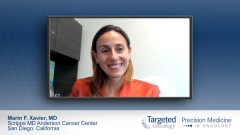
Novel Frontline Approaches Under Study for R/R DLBCL
An overview of potential strategies being explored to improve frontline therapy with R-CHOP for patients with relapsed/refractory diffuse large B-cell lymphoma.
Episodes in this series

Marin F. Xavier, MD: A couple of thoughts as you were speaking. That was an interesting 1 to look out for. We briefly mentioned R [rituximab]–polatuzumab–CHP [cyclophosphamide, hydroxydaunorubicin hydrochloride, prednisone] vs R-CHOP [rituximab, cyclophosphamide, hydroxydaunorubicin hydrochloride, vincristine, prednisone]. There’s another 1 comparing bispecifics; CD20 and CD19 with CHOP [cyclophosphamide, hydroxydaunorubicin hydrochloride, vincristine, prednisone] because that has CD20 in it. So there’s a lot going on in trying to determine for higher-risk patients, advanced stage or high risk, trying to improve upon the R-CHOP [rituximab, cyclophosphamide, hydroxydaunorubicin hydrochloride, vincristine, prednisone]. Stay tuned looking for those other combos in addition to adding tafasitamab to R-CHOP [rituximab, cyclophosphamide, hydroxydaunorubicin hydrochloride, vincristine, prednisone] as potential improvements in our previous outcomes. These randomized data are not available to change practice but exciting nonetheless.
The other thing that was a little interesting that we didn’t discuss is patients with activated B-cell type [ABC], some people use more R2 [lenalidomide, rituximab] off-label, but that’s a treatment. Looking at some potentially better outcomes in ABC subtype vs GCB [germinal center B cell] using monoclonal therapy, I don’t know if you can speak to that. It’s not on our script.
John M. Burke, MD: If you go back and look at older Revlimid [lenalidomide] data in DLBCL [diffuse large B-cell lymphoma], it’s not selective for ABC subtype. It has activity in both types of cell of origin, but it seemed to raise the outcome, improve the outcome in the ABC subtype a little more than it did in the GCB subtype, which was already doing better. That said, the trials of R-CHOP [rituximab, cyclophosphamide, hydroxydaunorubicin hydrochloride, vincristine, prednisone] with or without lenalidomide were somewhat different in the results, but they were both negative. That’s robust in the ECOG trial. So adding lenalidomide alone to R-CHOP [rituximab, cyclophosphamide, hydroxydaunorubicin hydrochloride, vincristine, prednisone] did not and probably will not become standard of care.
Moving forward with the synergy provided by tafasitamab and lenalidomide, it certainly seems rational that adding tafasitamab-lenalidomide to R-CHOP [rituximab, cyclophosphamide, hydroxydaunorubicin hydrochloride, vincristine, prednisone], as long as it could be done safely, could potentially improve upon R-CHOP [rituximab, cyclophosphamide, hydroxydaunorubicin hydrochloride, vincristine, prednisone]. CR [complete response] rates of 40% with tafasitamab-lenalidomide in the relapsed setting. As long as you can deliver your R-CHOP [rituximab, cyclophosphamide, hydroxydaunorubicin hydrochloride, vincristine, prednisone] in the frontline setting at an effective regimen like tafasitamab-lenalidomide, it certainly seems possible that you can improve on the outcome. We did find that in the First-MIND study, which is that tafasitamab-lenalidomide can be delivered safely with R-CHOP [rituximab, cyclophosphamide, hydroxydaunorubicin hydrochloride, vincristine, prednisone] and the dosing of R-CHOP [rituximab, cyclophosphamide, hydroxydaunorubicin hydrochloride, vincristine, prednisone] did not need to be compromised.
Marin F. Xavier, MD: Interesting. There’s mention of this Re-MIND trial. The Re-MIND trial is a real-world retrospective observational study that compared outcomes of the L-MIND with real-world patients receiving lenalidomide alone. To me, that was a trial that was more for the rest of the world to demonstrate that the combo is better than the lenalidomide alone. It absolutely does that. It was a very complicated nested cohort retrospective. It was an interesting study designed from an epigenomic perspective, but it didn’t really change any of my clinical impressions. It’s out there in case anyone wants to reference it.
John M. Burke, MD: That was an ingenious study. It was also for the FDA in that they had to show that tafasitamab was adding something to the lenalidomide.
Marin F. Xavier, MD: Right.
John M. Burke, MD: Either they do a big randomized trial or you go back and find a bunch of patients who had been treated with lenalidomide and then match them with your tafasitamab-lenalidomide patients.
Marin F. Xavier, MD: Yeah, it was complicated. They had matched controls. It was retrospective, and they had to have the same clinical features. It was quite a feat that they accomplished that trial. I agree. It was regulatory in this country as well. I do recall there being a lot of R-GemOx [rituximab, gemcitabine, oxaliplatin], a lot of rest-of-the-world salvage regimens that were also in there. It was complex, but it does prove the point, and the makers of tafasitamab were very pleased with how that reported out.
John M. Burke, MD: It really does make it look extremely clear that tafasitamab-lenalidomide is way better than lenalidomide alone, considering the limitations of the design of the study. It sure looks like tafasitamab-lenalidomide is much better than lenalidomide alone and that tafasitamab is adding significant benefit above and beyond what lenalidomide is providing. It surely makes you feel comfortable delivering that combination.
Marin F. Xavier, MD: That’s terrific. I’m always by the book, and lenalidomide is not FDA approved for large cell. I wouldn’t usually have done that, so it doesn’t speak to my practice that much because it’s a REMS [risk evaluation and mitigation strategy] program. I did it a couple of times for an ABC multiple-relapse disease. I didn’t want to do ibrutinib because of fungal infection risk. There are so much more data out there to guide us in the relapsed setting.
Transcript edited for clarity.








































